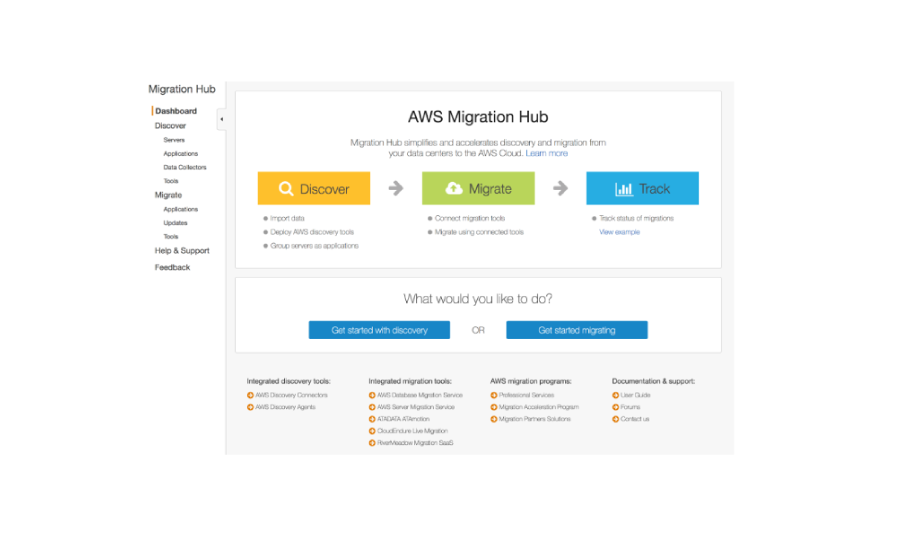
In parts one and two of this migration series, we discussed different programs that allow businesses to adopt their organizational and technical infrastructure for the cloud. We’ve also covered common migration strategies. As promised in our last installment, in this post we will review AWS technical services to empower migration—beginning with the AWS Migration Hub.

AWS Migration Hub
This service provides a single page to track different aspects of migration like planning, progress, and resources.

The different services that we will cover in this post report their data in the AWS Migration Hub.
AWS Application Discovery Service (ADS)
These services help customers in the migration planning, gathering information about the infrastructure, and application connections to be migrated. This allows users to fetch server utilization and dependency mapping data which can then be exported in a CSV format and queried using Amazon Athena or imported to AWS Migration Hub. This service is primarily used for infrastructure assessment in the planning stage of migration.
AWS Server Migration Service (SMS)
AWS Server Migration Service (SMS) is agentless and allows you to automate and schedule server migration tasks. It has connectors available for VMware ESXi and Microsoft HyperV servers. Using AWS SMS, customers can migrate not only a single server, but a group of instances, allowing companies to migrate complicated applications.
In this case, a list of services can be split into groups, each logically represented in one layer of an application (i.e. application layer, presentation layer or database layer). After each layer is migrated, AWS SMS can create a CloudFormation script that can be used to spin up and run this application in AWS cloud.

Another feature of AWS SMS is the ability to create a scheduled job that will periodically create new images from source services and then update the CloudFormation script with these new images. This feature can be used to ensure you have the latest application version cloud ready to deploy for disaster recovery purposes.
AWS CloudEndure Migration
AWS CloudEndure Migration is another service designed for service migration, the difference from AWS SMS is that CloudEndure works on a disk level of the source instances, replicating disk blocks from the source server to the target instance in AWS cloud. After the replication is finished, CloudEndure continues to monitor changes on the source machine and replicates them to the target.
Using CloudEndure, customers can apply the same approach to automate migrating different kinds of workloads like: databases (Microsoft SQL, Oracle Database) and different kinds of enterprise applications such as SAP.
On boarding CloudEndure allows companies to address other tasks than migration as well. For example, we can provide Disaster Recovery to other regions of a cloud, satisfying needed RTO and RPO criteria.

Database Migration
AWS Database Migration Service (DMS)
This is a tool that helps in database migration from different database engines to the one engine inside the AWS cloud. DMS also supports migrating your data warehouse.
For example, using DMS a customer can migrate their database workloads running on Oracle database to AWS Aurora service and received all benefits provided by the cloud adopted database solution. In these types of migrations there is another tool provided by AWS called Schema Conversion Tools (SCT)—which helps in converting database schema from one database engine to another.
DMS allows you to create a flexible set of rules for converting schema, applying changes on the fly, and to create or move features and capabilities from a source database instance to the target.
In SoftServe we have success stories involving DMS and SCT services for migrating database workloads from on-premise installation to the cloud, mainly to the AWS Aurora and Redshift. With the help of these tools, we were able to provide quality service—on time and budget.

Persistence Data Migration
For offline data migration AWS provides Snow Family solutions, including:
- Snowcone – move 8 TB of data to the cloud
- Snowball – move 50-80 TB of data to the cloud
- Snowball Edge – move 100 TB of data to the cloud
- Snowmobile – this is exabyte-scale storage in a 45ft container
For online data migrations there are the following options:
AWS Storage Gateway
A hybrid storage service which enables low-latency access from on-premises to data in AWS which is integrated with S3, Glacier, and Amazon EBS. It supports standard storage protocols like NFS, SMB, iSCSI. AWS Storage Gateway also has caching feature that allows to keep local cache of frequently accessed data.
AWS DataSync
Syncs data between on-premises and cloud but has integration with services like AWS FSx, EFS, and S3. Also, AWS DataSync supports one-time and incremental data-transfer in both directions on-premises to the cloud and vice versa.
Conclusion
We hope you have found this series to be informative and inspiring as we’ve covered different migration programs, strategies, and services offers to make infrastructure and data migration to AWS smooth and effective.
These insights have come from our continual use of all tool sets included in this series. As a Premier AWS Consulting Partner, SoftServe has a global team of cloud experts ready to advise, critically listen, and rapidly assess where you are, where you need to go, and how we can take you there.
Let's talk about your AWS migration journey and how SoftServe empowers enterprise companies to improve performance, efficiency, and TCO for their AWS investments.

